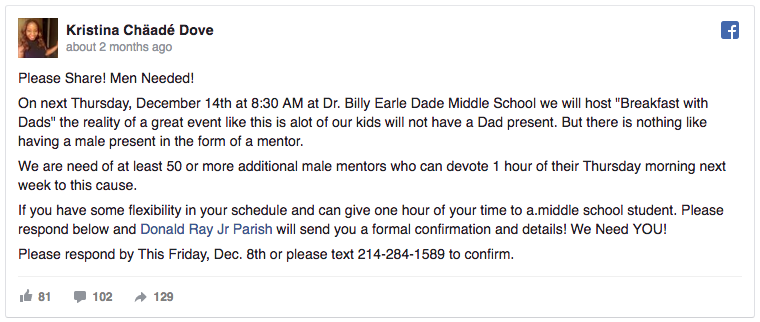 Back in February 2012, I wrote a blog called I’m a Frustrated Volunteer. It was about how often people try to volunteer but run up into so many roadblocks: incomplete, hard-to-understand information on the organization’s web site, lack of followup by the organization after the person expresses interest, no clear direction or support when they are trying to complete a volunteering task, etc. So often, when organizations, especially schools, tell me they can’t find volunteers, the problem is, in fact, they are turning potential volunteers away per the aforementioned challenges.
Back in February 2012, I wrote a blog called I’m a Frustrated Volunteer. It was about how often people try to volunteer but run up into so many roadblocks: incomplete, hard-to-understand information on the organization’s web site, lack of followup by the organization after the person expresses interest, no clear direction or support when they are trying to complete a volunteering task, etc. So often, when organizations, especially schools, tell me they can’t find volunteers, the problem is, in fact, they are turning potential volunteers away per the aforementioned challenges.
In that blog, I admitted that the frustrated volunteer wannabe I was describing was, in fact, ME, based on my experiences trying to volunteer oh-so many times since September 2009, when I moved back to the USA – Oregon, specifically. I noted that the upside with all this frustration was that my own attempts to volunteer had made me a better consultant and better manager regarding volunteer engagement, and the experience had generated a lot of new resources on my web site. Those experiences as a frustrated volunteer also influenced my writing of The Last Virtual Volunteering Guidebook.
It’s six years after that blog. Am I still a frustrated volunteer?
Yes. Yes, I am.
Here are some experiences I’ve had in trying to volunteer over the last few years:
- I wanted to volunteer at the local high school. I was ready to help with their drama club, their speech team, or any other club or class where my expertise might help the students. The home page for the school doesn’t even have the word volunteer on it. Once you find the page for potential volunteers, it has just three paragraphs: no information about what volunteers do, the minimum amount of commitment required, etc. The lead statement is “Our volunteers contribute more than $1.6 million worth of help each year — the equivalent of about 12 extra hours of adult time for every student in the district.” Yes, that’s right – volunteers are great because it means the school doesn’t have to hire people to do that work! Next…
- I wanted to explore volunteering with a local public service agency that supposedly involves volunteers in auxiliary support roles for staff engaged in a very intense activity. The web site has no info about this auxiliary, though I’m sure it exists. I wrote the person who is in charge of agency’s more labor-intensive, time-intensive volunteering. He wrote back and said he had some PDFs he could share with me about the program – but offered no summary of what the program was about, the application process, etc., and certainly no encouragement – I felt like I was bothering him. And why isn’t this information on the web site? He never said why. Next…
- I’ve wanted to volunteer to help girls go camping or to become leaders or to use tech both safely and to explore careers, but Girl Scouts doesn’t do those kinds of activities where I live, and another group that I thought did those things never got back to me after my TWO applications to volunteer. Next…
- I was interested in volunteering at a nearby jail to help people regarding résumé writing, finding volunteering after incarceration in order to build community ties and skills, interviewing skills, etc. But when I tried, I was told a religious-based organization was in charge of all of these volunteering activities, and I would need to contact that religious-based organization. I am not of that religion – in fact, I am not religious at all, and I felt like I wouldn’t be welcomed because I’m not religious and wouldn’t be helping from a faith-based motivation. I submitted my application, but I never heard anything back from the church in charge of the program. Next…
What volunteering has worked out for me?
- There’s a woman in the town where I live who is trying to start a nonprofit, and I’ve been able to help her with by-laws, writing a mission statement and other basic requirements.
- I still help Bpeace on occasion as an online volunteer. And, BTW, Bpeace is awesome – check them out.
- I signed up online to help at a forum for candidates running for a particular office. I ended up being the greeter at the sign-in table, something that I actually really enjoy. I wasn’t given much guidance – good thing I’ve worked a LOT of registration tables over the years. But it was over in just three hours. No more candidate forums until the Fall, before the November election.
- I’m still volunteering online with TechSoup, contributing information to their community forum.
- I’m serving on a citizens’ committee for public safety in the town where I live; after a year, the committee has come up with exactly zero recommendations to police and fire or the city council regarding safety in our town, and other committee members have balked at my ideas regarding pedestrian and bicyclist safety. Still, she persisted…
Online volunteering is super easy to find, as always, and I love it. But I continue to be frustrated in my attempts to be an onsite volunteer in activities that I feel a personal passion about. And I know that this is a chronic problem. Wouldn’t it be great if, instead of campaigns to get people to volunteer, we had funding and training for nonprofits, public sector agencies and schools about how to appropriately on-board and engage volunteers?
So, what volunteers has your initiative been turning away?
More on this subject:
- Required Volunteer Information on Your Web Site
- If I can’t find what I’m looking for on your web site, who else can’t?
- for volunteers: how to complain
- Are charities “stuck up” – or the corporate volunteers offering help?
- keep volunteer info up-to-date or else
- How to get rid of volunteers
- No excuses for not having the word “volunteer” on your home page!
- What is impressive, what is not.
- The volunteer as bully = the toxic volunteer
- A fire station turns away volunteers – and how it could be different
- A missed opportunity with volunteers
- latest moment of volunteer management madness
- When the volunteer coordinator needs an improvement plan
- How to handle online criticism
- Walk the Talk
- Is your organization a buzz kill?
- What you say vs. what you do re: volunteers
- What is “too much” from an online contributor?
- How do I get to you sans car?
- How easy is it to volunteer at your organization?
- What really happens when someone wants to volunteer with you







